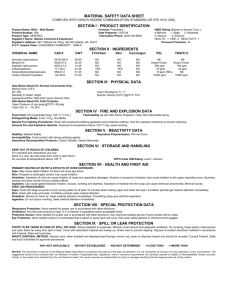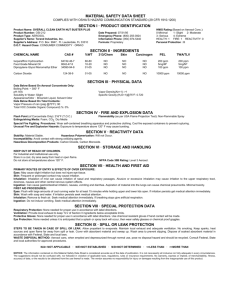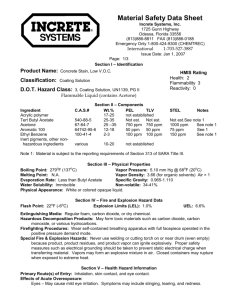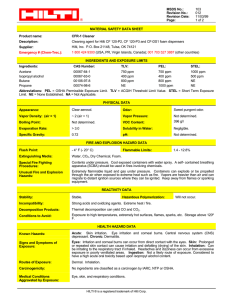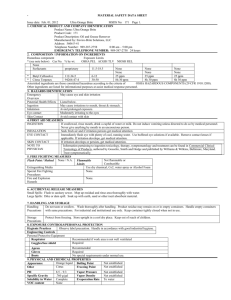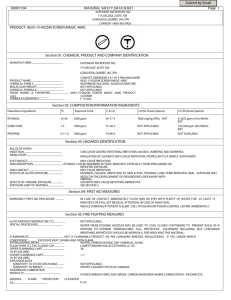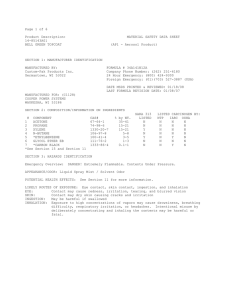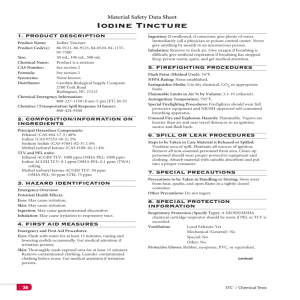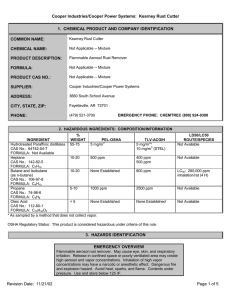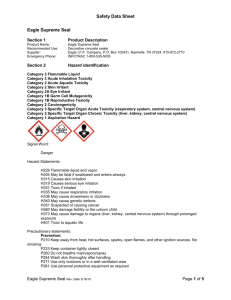MSDS/SDS
advertisement
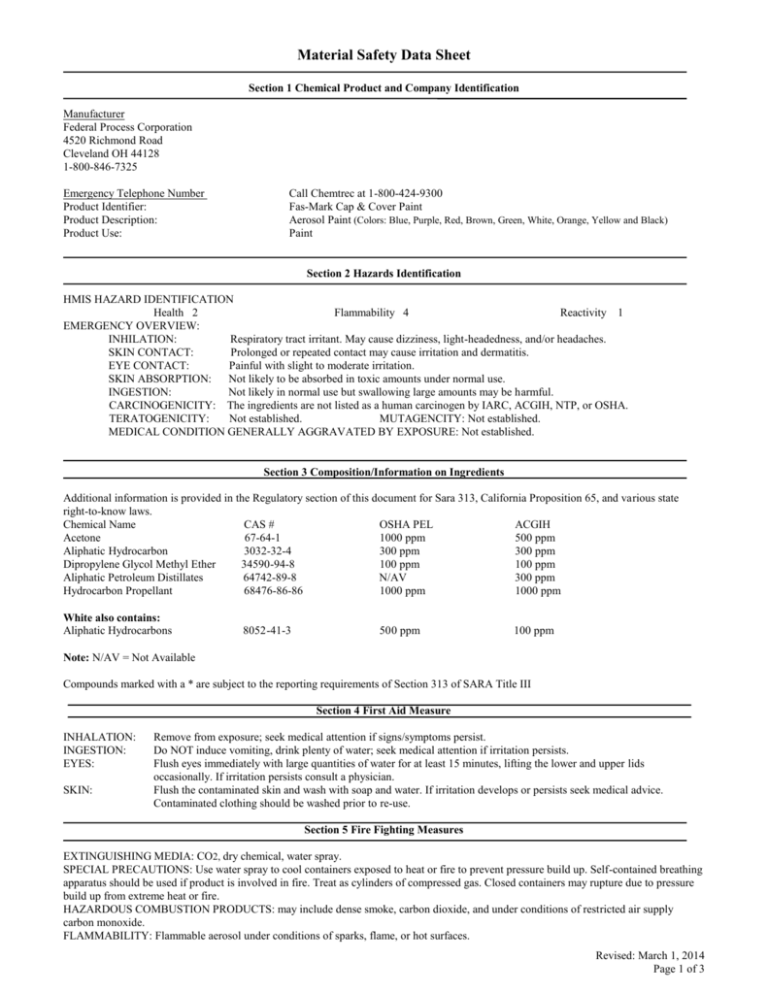
Material Safety Data Sheet Section 1 Chemical Product and Company Identification Manufacturer Federal Process Corporation 4520 Richmond Road Cleveland OH 44128 1-800-846-7325 Emergency Telephone Number Product Identifier: Product Description: Product Use: Call Chemtrec at 1-800-424-9300 Fas-Mark Cap & Cover Paint Aerosol Paint (Colors: Blue, Purple, Red, Brown, Green, White, Orange, Yellow and Black) Paint Section 2 Hazards Identification HMIS HAZARD IDENTIFICATION Health 2 Flammability 4 Reactivity 1 EMERGENCY OVERVIEW: INHILATION: Respiratory tract irritant. May cause dizziness, light-headedness, and/or headaches. SKIN CONTACT: Prolonged or repeated contact may cause irritation and dermatitis. EYE CONTACT: Painful with slight to moderate irritation. SKIN ABSORPTION: Not likely to be absorbed in toxic amounts under normal use. INGESTION: Not likely in normal use but swallowing large amounts may be harmful. CARCINOGENICITY: The ingredients are not listed as a human carcinogen by IARC, ACGIH, NTP, or OSHA. TERATOGENICITY: Not established. MUTAGENCITY: Not established. MEDICAL CONDITION GENERALLY AGGRAVATED BY EXPOSURE: Not established. Section 3 Composition/Information on Ingredients Additional information is provided in the Regulatory section of this document for Sara 313, California Proposition 65, and various state right-to-know laws. Chemical Name CAS # OSHA PEL ACGIH Acetone 67-64-1 1000 ppm 500 ppm Aliphatic Hydrocarbon 3032-32-4 300 ppm 300 ppm Dipropylene Glycol Methyl Ether 34590-94-8 100 ppm 100 ppm Aliphatic Petroleum Distillates 64742-89-8 N/AV 300 ppm Hydrocarbon Propellant 68476-86-86 1000 ppm 1000 ppm White also contains: Aliphatic Hydrocarbons 8052-41-3 500 ppm 100 ppm Note: N/AV = Not Available Compounds marked with a * are subject to the reporting requirements of Section 313 of SARA Title III Section 4 First Aid Measure INHALATION: INGESTION: EYES: SKIN: Remove from exposure; seek medical attention if signs/symptoms persist. Do NOT induce vomiting, drink plenty of water; seek medical attention if irritation persists. Flush eyes immediately with large quantities of water for at least 15 minutes, lifting the lower and upper lids occasionally. If irritation persists consult a physician. Flush the contaminated skin and wash with soap and water. If irritation develops or persists seek medical advice. Contaminated clothing should be washed prior to re-use. Section 5 Fire Fighting Measures EXTINGUISHING MEDIA: CO2, dry chemical, water spray. SPECIAL PRECAUTIONS: Use water spray to cool containers exposed to heat or fire to prevent pressure build up. Self-contained breathing apparatus should be used if product is involved in fire. Treat as cylinders of compressed gas. Closed containers may rupture due to pressure build up from extreme heat or fire. HAZARDOUS COMBUSTION PRODUCTS: may include dense smoke, carbon dioxide, and under conditions of restricted air supply carbon monoxide. FLAMMABILITY: Flammable aerosol under conditions of sparks, flame, or hot surfaces. Revised: March 1, 2014 Page 1 of 3 SENSITIVITY TO IMPACT: Product will be expelled if container is punctured. SENSITIVITY TO STATIC CHARGE: Primary vapors. FLASH POINT: <0° F (-18° C) LOWER FLAMMABLE LIMIT: 0.7% UPPER FLAMMABLE LIMIT: 12.8% AUTOIGNITION TEMPERATURE: Not established Section 6 Accidental Release Measures Remove all sources of ignition. Ventilate area. Prevent from entering a watercourse. Use an inert absorbent material. Collect and dispose of the contaminated absorbent in accordance with local state and federal laws. Section 7 Handling and Storage HANDLING: Avoid contact with the skin and eyes. Provide adequate ventilation. No smoking or open flame in storage areas. Wash hands after using product and before eating, drinking, smoking or using toilet facilities. STORAGE: Do not store above 120°F (49° C). WASTE DISPOSAL METHOD: Dispose of in accordance with local, sates and federal regulations. Do not puncture or incinerate cans. OTHER PRECAUTIONS: Do not smoke while using this product. Dust from sanding dry paint film should be treated as a nuisance dust with a TLV of 15 mf/cubic meter. Section 8 Exposure Controls/Personal Protection VENTILATION REQUIREMENTS: General ventilation to maintain exposure limits below TLV’s as defined in section II. PERSONAL PROTECTION: EYE: Safety glasses or goggles. GLOVES: Chemical resistant gloves such as Neoprene or Nitrile rubber. RESPIRATORY: Use NIOSH approved Organic Vapor Cartridge Respirator. For concentrations above the TLV (as defined in section II), use a positive air supplied respirator. OTHER: Avoid prolonged or repeated contact. Do not breathe vapors. Wash contaminated clothing prior to reuse. Section 9 Physical and Chemical Properties PHYSICAL STATE: ODOR AND APPEARANCE: LOWEST BOILING POINT: VAPOR DENSITY: % ORGANIC VOLATILES: Aerosol can Strong solvent odor. Does not apply Heavier than air <65% PRESSURE IN CAN: VAPOR PRESSURE: WATER SOLUBILITY: pH Approx 77 psig Not established Insoluble Not applicable Section 10 Stability and Reactivity STABILITY: This product is stable under recommended conditions of storage and handling. REACTIVITY: Product may react with strong oxidizers or strong acids Section 11 Toxicological Information Exposure limits: The limits reported in Section 2 of this document refer to other physical forms of the ingredients present in this product. Limits for the formulated product have not been determined. None of the components of this product have been reported as carcinogenic by NTP, OSHA or IARC. Section 12 Ecological Information General: Not expected to present any significant ecological problems. Section 13 Disposal Information Waste materials must be disposed of in accordance with your municipal, state, provincial and federal regulations. Contact the proper authorities for specific instructions. Section 14 Transportation Information DOT HAZARD CLASS: PROPER SHIPPING NAME: IDENTIFICATION NUMBER: Consumer commodity ORM-D Consumer commodity ORM-D None Revised: March 1, 2014 Page 2 of 3 Section 15 Regulatory Information Listed below are chemical substances subject to supplier notification requirements. The percentages, when present represent average values. CAS Number SARA WHMIS CA-65 313 Liquified Petroleum Gas 10 - 30% CA-65 - Chemical substances identified under the California Proposition 65 column are known to the State of California to cause cancer and/or reproductive toxicity. TSCA STATUS: All ingredients of this product comply with the requirements of the US EPA Toxic Substances Control Act. Section 16 Other Prepared by R. L. The above information and recommendations are believed accurate and reliable. Because it is not possible to anticipate all conditions of use, additional safety precautions may be required. The Federal Process Corporation makes no warranty, either express or implied, including merchantability and fitness. USER RESPONSIBILITY: Each user should read and understand this information and incorporate it into individual site safety programs in accordance with applicable hazard communication standards and regulations. Revised: March 1, 2014 Page 3 of 3

